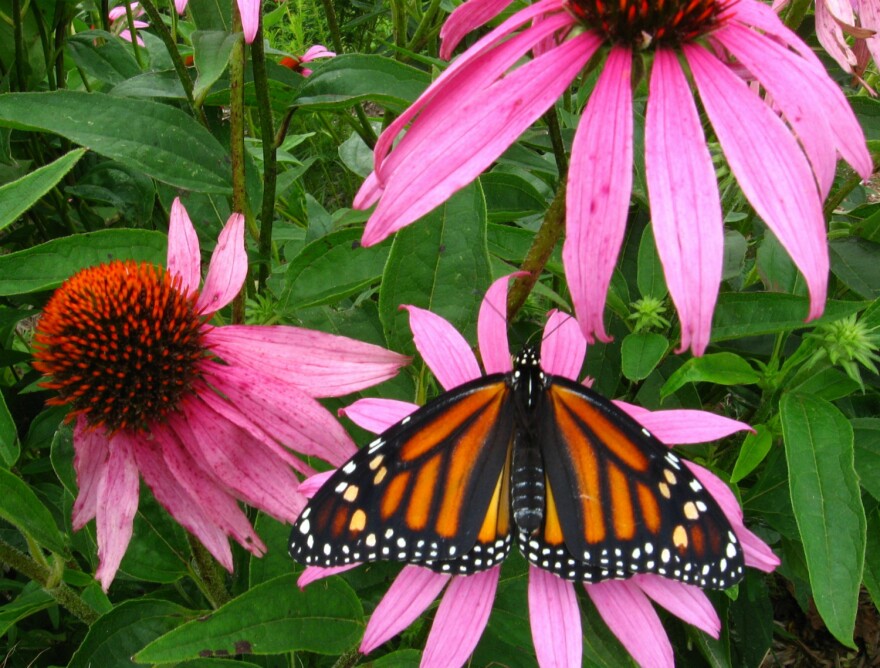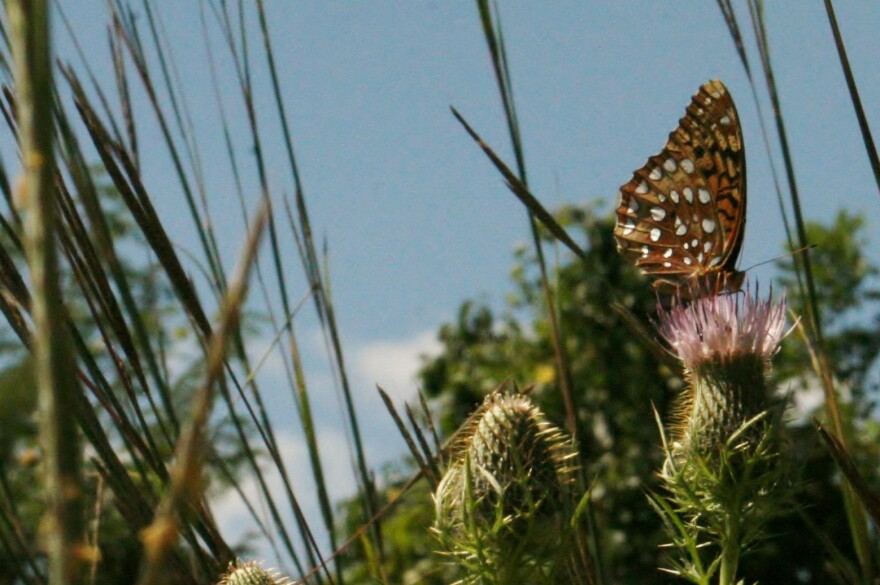This article first appeared in the St. Louis Beacon: You’re walking south along Skinker next to Forest Park. Going past the golf course, you decide to turn into the park. Bordering mowed pathways, sky high grasses grow, and yellow flowers bloom above your head. Bees, bumblebees, butterflies, and beetles flit or crawl around on pink Monarda, black-eyed Susans, yellow flowers and grasses too numerous and varied to name. Insects hum. A goldfinch flies around.
Toward the art museum, the wall of vegetation spreads farther and farther, merging with Kennedy woods. You’ve just walked through Kennedy savanna, one of the city’s most stunning examples of a type of ecosystem that once dominated in Missouri, a tallgrass prairie-savanna.
What are prairies and savannas?
According to the Missouri Prairie Foundation, a tallgrass prairie is an ecosystem dominated by grasses, with some non-woody, flowering herbaceous plants in the mix, and 10 percent or less of tree cover.
A savanna is a prairie with 30 percent or less tree cover. Prairie-woodlands have more trees than savanna and still retain an “open structure,” allowing enough light to encourage tall grasses other herbaceous plants to grow.
While the 20-acre Kennedy prairie-savanna and the other prairie plantings in Forest Park are only a tiny slice of what St. Louis used to have before European settlement, they still help wildlife. They host more than 200 species of plants and insects and function as prime habitat for thousands of migrant birds using the Mississippi River as a flyway, says Peter Van Linn, park ecologist for Forest Park Forever, as well as those birds that live here year round.
“A lot of those birds will use the Mississippi River as flyway for brooding, feeding,” says Van Linn. Besides being ideal breeding habitat for goldfinch, indigo buntings and numerous types of sparrows, the prairie-savanna makes a great hunting spot for birds of prey such as hawks, falcons and eagles.
“They like to sit on the oak trees and look down. They can see prey really easily. It’s a hunting perch,” Van Linn said.
Open space and bird houses have also lured bluebirds back into the city park, says Mitch Leachman, executive director of the St. Louis Audubon Society. “They really want open space,” he said.
Missouri: Once a sea of grass
Unlike the thickly wooded forest that now dominates wild places in Missouri, settlers encountered a sea of grass dotted with oak and hickory trees when they came.

“This open structure that you can see through is closer to what Missouri’s forests were [200 years ago],” said Shaw Nature Reserve restoration biologist James Trager, who manages 250 acres of tallgrass ecosystems there -- and is planning more.
“More than one-third of Missouri was prairie once upon a time,” says Doug Ladd, director of conservation science for the Missouri Nature Conservancy. “Fifty percent of St. Louis city and county was prairie, managed largely by Native Americans.”
“The Indians burned to manage habitat,” said Trager. “Trees were not as important to them as they were to white settlers.”
Burning not only improved hunting conditions for bison, elk and deer, it also helped useful plants such as wild grasses and non-woody plants to grow.
“Wild stock fed on grains from wild grasses,"said Trager. "People harvested the wild grains. They harvested tubers.” Prairie plants such as Echinacea (purple coneflower) currently a popular herbal supplement, were their pharmacopeia.
“They made medicines,” he said.
As prairie grasses grew for thousands of years, their large root systems and digging insect populations aerated and incorporated organic nutrients and water into the ground, building a deep layer of fertile topsoil.
Once settlers arrived, prairies were plowed over and farmed, or built upon. The process sped up when, in 1837, John Deere invented a plow with a steel blade that made cutting through sticky prairie soils much easier.(according to John Deere website)
Less than one half of 1 percent of the original tallgrass prairies remain in Missouri, says Ladd, making them one of the most endangered habitats in the world.
“The most endangered, least conserved habitats on earth are temperate grasslands,” Ladd said. “Where did humanity evolve agriculture? Temperate grasslands. One of the most endangered phases of temperate grasslands are tallgrass prairies, which is the most productive phase of prairies in North America and also the most agriculturally productive.”
Burning and conserving
Organizations such as the Missouri Prairie Foundation, the Missouri Nature Conservancy, the Audubon Society, and Missouri Botanical Garden are working with state agencies and private landowners to construct, reestablish and rebuild tallgrass ecosystems throughout the state. Plantings such as the one in Forest Park not only help wildlife, they also help to educate the public on the beauty and utility of prairie ecosystems, biologists say.
Over the past seven years, the Missouri Department of Transportation has worked with the Missouri Botanical Garden to plant 20 acres of “Prairie Rehab” along some Missouri highways, and it plans to do more, says MoDOT district maintenance engineer Betty Allmeroth. While not “true” prairies, the highway plantings of grasses and wildflowers control erosion and help to absorb runoff, she said.

Local gardeners, too, are planting native wildflowers and grasses, which, with large root systems, are drought-resistant, and feed birds and pollinators with their flowers and seeds.
“Every little bit helps,” said Missouri Department of Conservation biologist Mike Arduser.
While some native plants are being re-established, it’s still the wide swaths of prairie that benefit wildlife, especially endangered wildlife, the most. And, in this fragmented world, they require maintenance.
“If you don’t manage a prairie appropriately, it’s gone,” said Arduser. “It turns into trees and shrubs.”
Arduser, Trager and Van Linn are all “burn bosses” who create and implement burn plans on the lands that they manage. Burns, which happen every few years, retard the growth of trees and return organic nutrients to the ground. Because of the risks, they are used sparingly and generally take place in the winter.
“The problem is, we can’t use it enough. We have to be very judicious about where we use fire. We have to be very careful,” said Arduser.
Van Linn agrees. Only two burn events have ever taken place in Forest Park, he said. When burns are not possible, herbicide is applied.
Other aspects of prairie maintenance include removing invasive species such as bush honeysuckle and euonymous vine.
Building a tallgrass prairie
Trager walks across cleared land that has been cleared for prairie building at Shaw Nature Reserve. Contrary to what one might expect, building, restoring and maintaining grasslands are labor-intensive.
First, an old field or prepared ground is mowed. Then the existing vegetation is burned. At some point, herbicide might be applied but never fertilizer, as it encourages invasive species (such as fescue and red clover) to take over.

Once the ground is deemed ready to accept prairie seeds, volunteers come and spread them during the winter. The seeds are not purchased but are collected locally from wild plants. These seeds, biologists say, have the best chance of surviving, since they’re the best adapted to this environment.
It takes years for a prairie to mature, all the biologists said. But seeing the endless variation, month to month and year to year, is part of the fun.
“Every year looks different," said Trager. "The components are the same, but they’re in different patterns. There are things that don’t happen every year.”
He indicates several prairie plantings, around different ponds. Although the seed mix was the same, all have dramatically different flora. One is dominated by Rose Mallow, a native hibiscus. Another boasts expanses of Queen Anne’s Lace.
“Every one’s so different," said Trager. "It’s fun to see that happen.”


